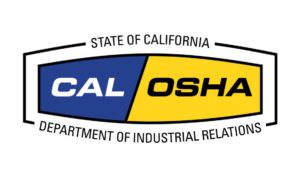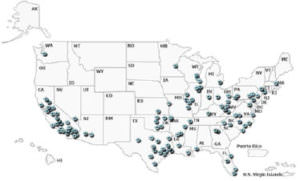
June is National Safety Month, as deemed by the National Safety Council. Nationally, worker safety and health on the job is advocated through the Department of Labor’s Occupational Safety and Health Administration –OSHA. In addition to OSHA regulations, further worker protection is provided by individual state regulatory agencies. In California, that agency is the Division of Occupational Safety and Health (DOSH) and it is better known as Cal/OSHA. Nationally, Cal/OSHA is known to be a trailblazer for developing the most stringent regulations to protect employees. Often, other states look to this agency’s regulations as an example to follow and mirror for adoption into their own states.
Outdoor working conditions began showing up on Cal/OSHA’s radar in 2006 after a July heat wave took the lives of multiple workers. During the last ten years, the agency has created important mandates to regulate outdoor workplaces to prevent heat illness and undue fatalities. This map from OSHA shows why this is a real concern in California:
 More recently, in 2015 Cal/OSHA amended the Heat Illness Prevention Regulation. While there are many specific codes, it is important to note if you operate a business in California with workers that are directly impacted by hot working conditions outdoors there is one particular regulation to be sure to review: Title 8 Section 3395 – Heat Illness Prevention. This regulation can significantly affect your daily operating procedures. To summarize in the most basic terms, it requires California employers with agricultural workers, construction workers, landscapers and any other industry with outdoor workers to provide more than adequate water, shade, rest breaks and training. This rule applies when temperatures are over 80°F; however, it should be noted that additional requirements apply when the outdoor temperature exceeds 95°F. Cal/OSHA has determined that at 95°F, outdoor workers are at high risk for heat-related illnesses and a more stringent set of rules must be followed.
More recently, in 2015 Cal/OSHA amended the Heat Illness Prevention Regulation. While there are many specific codes, it is important to note if you operate a business in California with workers that are directly impacted by hot working conditions outdoors there is one particular regulation to be sure to review: Title 8 Section 3395 – Heat Illness Prevention. This regulation can significantly affect your daily operating procedures. To summarize in the most basic terms, it requires California employers with agricultural workers, construction workers, landscapers and any other industry with outdoor workers to provide more than adequate water, shade, rest breaks and training. This rule applies when temperatures are over 80°F; however, it should be noted that additional requirements apply when the outdoor temperature exceeds 95°F. Cal/OSHA has determined that at 95°F, outdoor workers are at high risk for heat-related illnesses and a more stringent set of rules must be followed.
To stand in compliance with these regulations above 95°F, business owners must provide a minimum ten-minute net preventative cool-down rest period every two hours, as well as provide workers drinking water, first aid and emergency response. Additionally, employers must have in place “an effective Injury and Illness Prevention Program (IIPP)” as outlined by Cal/OSHA. You can peruse the particulars in the link above for Title 8 Section 3395.
The key takeaways, however, to make sure your business stays ahead of regulation is to implement preventative measures. Your planning (and if in California, to be outlined in your IIPP) should include: